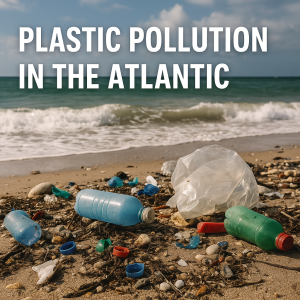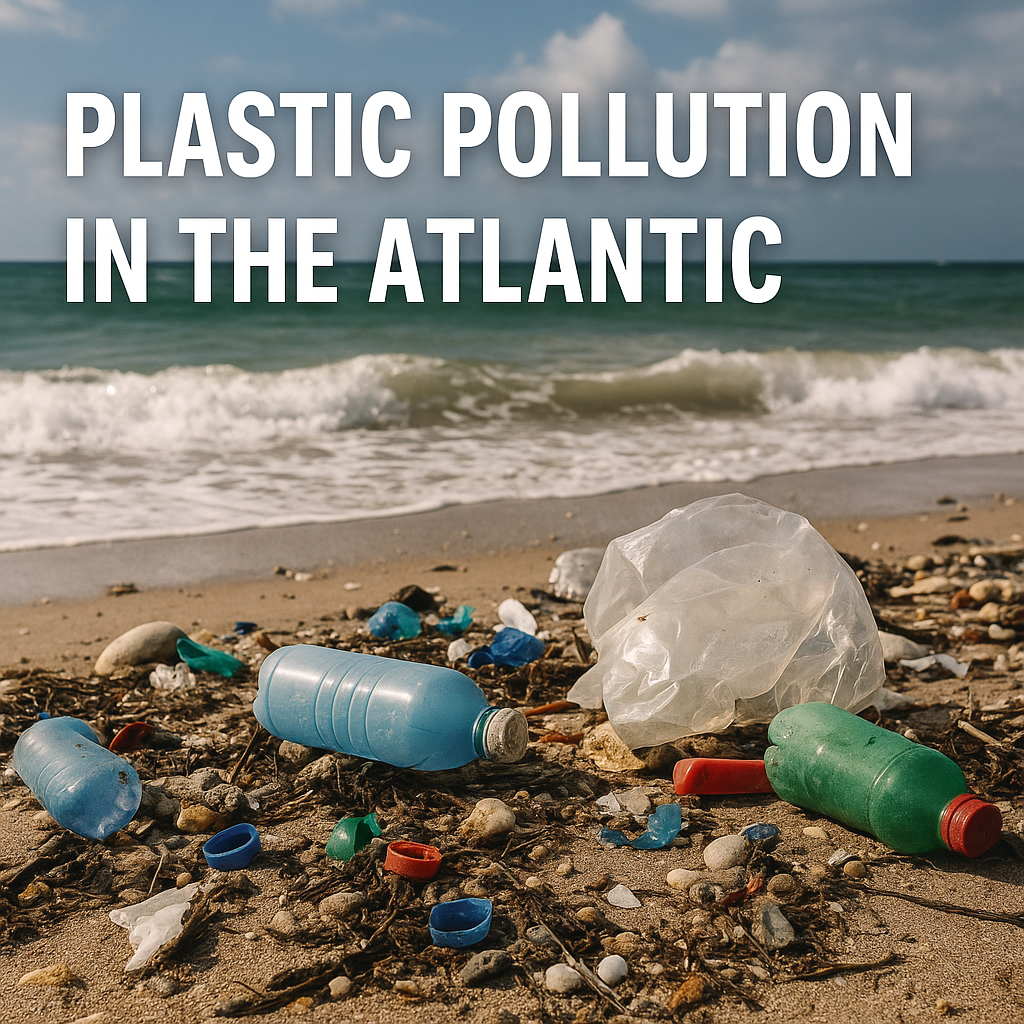 Explore the growing threat of plastic pollution in the Atlantic Ocean and discover innovative solutions shaping maritime sustainability.
Explore the growing threat of plastic pollution in the Atlantic Ocean and discover innovative solutions shaping maritime sustainability.
The Atlantic Ocean, stretching from the Arctic in the north to the Antarctic in the south, has long been a vital artery for global maritime trade, ecological balance, and human livelihood. Yet, beneath its vast blue surface lies a mounting crisis: plastic pollution. An estimated 11 million metric tons of plastic waste enter the world’s oceans annually, with the Atlantic accounting for a significant share (UNEP, 2023). In fact, a 2020 study published in Nature Communications estimated that the Atlantic Ocean contains up to 21 million tonnes of plastic just in its upper layers—a volume much greater than previously assumed.
The presence of plastic debris—from microplastics to large ghost nets—disrupts marine ecosystems, endangers biodiversity, and threatens coastal and offshore industries. For maritime professionals, port authorities, fisheries, and coastal communities, plastic pollution is no longer a distant environmental concern. It directly impacts operational safety, vessel integrity, and long-term ocean health.
This article explores the scale of plastic pollution in the Atlantic, its impacts on maritime operations, and the multi-level solutions emerging from science, policy, and industry.
Sources and Types of Plastic Entering the Atlantic
Land-Based vs. Marine-Based Sources
The majority of marine plastic pollution originates on land—primarily via rivers, stormwater runoff, and poor waste management. According to a report by the International Maritime Organization (IMO) and UNCTAD, about 80% of ocean plastic comes from land-based sources, while the remaining 20% is marine-based, such as from fishing gear, shipping, and offshore platforms.
Notable river systems like the Amazon, Congo, and Mississippi all feed plastic waste into the Atlantic. Meanwhile, port cities with inadequate waste processing infrastructure contribute significantly to coastal pollution.
Types of Plastic Found
- Macroplastics: Fishing nets, ropes, plastic bags, beverage bottles
- Microplastics: Plastic particles <5mm from cosmetics, synthetic textiles, and broken-down macroplastics
- Nurdles: Pre-production plastic pellets accidentally spilled during transport
- Ghost Gear: Abandoned fishing nets and gear drifting with currents
A 2022 joint study by NOAA and the World Ocean Review found that ghost fishing gear accounts for up to 70% of large plastic debris in some Atlantic gyres.
The North Atlantic Garbage Patch: A Growing Vortex
While the Pacific Ocean’s plastic accumulation zone is more publicized, the North Atlantic Garbage Patch, located between the Azores and Bermuda, is equally troubling. Trapped by the North Atlantic Subtropical Gyre, this floating soup of plastic spans thousands of kilometers. Research from the 5 Gyres Institute shows that while much of the debris is not visible on the surface, the water column and seabed are becoming repositories of hidden plastic waste.
For mariners, the implications are tangible: increased hull fouling, propeller entanglements, and navigational hazards. In 2023, Lloyd’s Register issued a safety bulletin warning that unmonitored plastic hotspots can pose operational risks to both commercial and fishing vessels.
Impacts on Maritime Industries and Ocean Life
Fisheries and Aquaculture
Plastic debris damages fishing nets, contaminates catches with microplastics, and reduces fish stocks by altering habitats. A 2022 FAO report indicated that microplastics have been found in over 114 aquatic species, many of which are commercially valuable. Shellfish aquaculture zones, particularly along the coasts of Canada, Scotland, and West Africa, face growing contamination risks.
Shipping and Port Operations
For ports and harbors, floating plastic impedes vessel maneuvering, clogs intakes, and increases dredging costs. The British Ports Association (BPA) and ESPO have both highlighted that plastic debris in port basins contributes to delays and maintenance costs. In 2021, the Port of Rotterdam reported removing more than 20 tonnes of floating plastic annually from its waters.
Human Health and Coastal Economies
Coastal communities relying on tourism and fisheries suffer when beaches are littered and waters polluted. Microplastics entering the food chain through seafood consumption pose long-term health risks, including hormonal disruption and carcinogenic exposure (Marine Pollution Bulletin, 2022).
Innovative Technologies and Cleanup Solutions
Ocean Cleanup Projects
One of the most publicized efforts is The Ocean Cleanup, which has deployed passive plastic collection systems in both the Pacific and Atlantic Oceans. As of early 2024, the organization has extracted over 100,000 kg of plastic from the North Atlantic, using its System 002 and upgraded 003 collection arrays.
Port and River Interceptors
- Baltimore’s Mr. Trash Wheel intercepts floating trash before it reaches the Chesapeake Bay.
- The Port of Antwerp uses autonomous drones and skimmers to collect surface plastics.
- The Seabin Project, active in over 50 Atlantic ports, has removed 1.4 million kg of waste since 2018.
Smart Detection and Monitoring
Remote sensing tools and satellite platforms like ESA’s Sentinel-2 and NOAA’s Marine Debris Monitoring help track plastic hotspots. DNV and Wärtsilä Voyage are piloting onboard AI-based visual detection systems that warn crews of plastic concentration zones in shipping lanes.
Maritime Policy and International Regulations
IMO MARPOL Annex V
Annex V of the International Convention for the Prevention of Pollution from Ships (MARPOL) prohibits the discharge of plastics from ships. Since its 2013 amendment, even incinerated plastic ash is regulated. Port State Control authorities, especially under Paris MoU and Tokyo MoU, inspect vessels for compliance.
Regional Action Plans
- OSPAR Convention: Aims to reduce marine litter in the North-East Atlantic
- Abidjan Convention: Addresses pollution in the Atlantic coasts of West, Central, and Southern Africa
- European Strategy for Plastics in a Circular Economy: Focuses on reducing single-use plastics and promoting biodegradable alternatives
Extended Producer Responsibility (EPR)
In 2023, the UNEP Global Plastics Treaty negotiations began pushing for mandatory EPR schemes, where manufacturers are responsible for plastic waste collection and processing. If enforced globally, this would ease the burden on maritime systems.
Case Studies
Ghana’s Port of Tema
Partnering with UNDP, the Port of Tema launched a pilot to install plastic traps in stormwater channels, preventing waste from reaching the Atlantic. Over 12 months, the program diverted over 6,000 kg of plastic waste into recycling streams.
Halifax Harbour, Canada
Halifax partnered with Clearwater Seafoods and the Ocean Frontier Institute to deploy floating bins and AI-based monitoring. Results showed a 28% reduction in surface plastic density over 18 months.
Canary Islands Marine Reserve
A protected area off the coast of Lanzarote banned single-use plastics in its ports and ferries. Supported by the Spanish Ministry of Ecological Transition, the reserve recorded a 60% drop in macroplastic beach debris within two years.
Future Outlook: Charting a Cleaner Course
Solving the Atlantic’s plastic pollution crisis requires a hybrid strategy:
- Policy enforcement through stronger IMO-led regulations
- Technology integration in both cleanup and detection
- Circular economy investment to reduce plastic production and improve recycling
- Maritime education and behavior change, especially among seafarers and port workers
By 2030, experts estimate that without intervention, plastic in the ocean will triple to 29 million metric tonnes annually (UNEP, 2021). But with coordinated maritime action, innovation, and political will, the Atlantic can still be safeguarded for generations to come.
Frequently Asked Questions
What is the main source of plastic in the Atlantic Ocean?
Land-based sources, especially poorly managed waste from cities and rivers, contribute about 80% of plastic pollution.
Are there specific laws banning plastic at sea?
Yes. Under MARPOL Annex V, it is illegal for ships to dump plastic waste into the sea. Port State Control inspections help enforce this.
What are ghost nets, and why are they dangerous?
Ghost nets are abandoned fishing nets that drift freely, entangling marine life and damaging ecosystems. They also pose risks to ship propellers.
How does plastic pollution affect ship safety?
Plastic can clog water intakes, damage engines, and increase the risk of collisions or fouling, particularly in plastic accumulation zones.
Is there a solution to plastic pollution in the ocean?
Yes. Solutions include better waste management on land, stricter maritime laws, cleanup technologies, and shifting to reusable or biodegradable materials.
How can seafarers help reduce plastic pollution?
By following MARPOL rules, minimizing onboard plastic use, and reporting plastic hotspots to port authorities or relevant agencies.
What is the role of ports in combating plastic pollution?
Ports can install interceptors, enforce plastic bans, and invest in waste reception facilities and circular economy initiatives.
Conclusion
Plastic pollution in the Atlantic Ocean is a silent crisis with loud consequences. For those who live and work on the sea—from fishermen to ship captains and port managers—its presence is both visible and disruptive. Yet, the tide is beginning to turn. Through a blend of smart policy, emerging technologies, and a shift in how industries approach plastic use, the Atlantic has a fighting chance.
As maritime professionals, educators, and global citizens, we are all stakeholders in this cleanup mission. The plastic problem may be vast, but the collective momentum behind change is growing stronger every day. The Atlantic deserves no less.
References
- International Maritime Organization (IMO) – https://www.imo.org
- Marine Pollution Bulletin (Elsevier) – https://www.journals.elsevier.com/marine-pollution-bulletin
- UNEP Reports – https://www.unep.org/resources
- OSPAR Commission – https://www.ospar.org
- World Ocean Review – https://worldoceanreview.com
- NOAA Marine Debris Program – https://marinedebris.noaa.gov
- The Ocean Cleanup – https://theoceancleanup.com
- British Ports Association (BPA) – https://www.britishports.org.uk
- Port of Rotterdam – https://www.portofrotterdam.com
- DNV Maritime Sustainability – https://www.dnv.com
- ESPO Environmental Report – https://www.espo.be
- Wärtsilä Voyage – https://www.wartsila.com
- MarineTraffic – https://www.marinetraffic.com
- UNCTAD Review of Maritime Transport – https://unctad.org/topic/transport-and-trade-logistics/review-of-maritime-transport

